So, you want to paint. But, just getting started and choosing the right subject matter to paint is a challenging task to many aspiring artists. Even professional artists find themselves lacking in inspiration from time to time – I know I do.
Imagine this, lets say you set up a still life with an ordinary apple as your subject matter…after a few minutes you might find yourself asking, ‘Well, what do I want to do with this?’ This struggle is because you uncertain and uninspired about your subject matter choices.
The 7 methods listed below will help you understand how to take a fresh look at your subject matter for new artistic inspiration. Just take a look at all the different ways in which talented artists can interpret an ordinary apple in paint! ~Lori
Guest author: Art Bistro. Originally post on ArtBistro.Monster.com
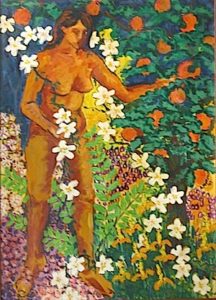
For the Sunday painter, an apple (or anything else — a tree, a face, a barn door) exists as an object that, if you are skillful at it, can be rendered faithfully and maybe even beautifully. For the professional artist, the objects of the world are reference points that connect to a vast array of possible ideas, subject matter choices, and intentions. For the professional artist, an apple is not just an apple—it is a starting point. An artist may decide to use an apple in any of the following ways and many, many more!
1. Make It Gigantic

He may be interested in the psychological effects of objects, not in their accurate portrayal, and may want, for example, to fill his canvas with a single apple so as to give it a singular power and presence, the way Georgia O’Keefe painted flowers “as if they were skyscrapers.” Picture a red apple completely filling a canvas all the way to the edges and feel through what psychological effects that image might have on a viewer.
2. Make It The Important Detail
Picasso often lamented, perhaps tongue-in-cheek, that viewers never realized that the peach in the painting they were viewing was not a detail but its very reason for being. “The whole painting is for the sake of that peach!” he would cry. Your painting may include many things but it may be the apple that really matters to you and that you intend to make matter to a viewer — the very reason, in short, you painted that painting.
3. Alter It Slightly or Completely
You may decide to alter the apple’s look for artistic, psychological, social, philosophical or spiritual reasons, making it surrealistically weep, presenting it as solid as a rock as everyman’s fruit (think of Van Gogh’s “Potato Eaters”), giving it a wispy look as an object in Heaven, and so on.
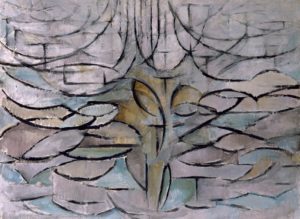
Or you may alter it so radically and drastically that it becomes a cubist fantasy, Mondrian-like, or otherwise completely unrecognizable. To get a sense of this process of altering you might track the many studies that Mondrian made as he further and further abstracted an apple tree until its final incarnation (see, for instance, his “Apple Tree in Flower” as one example).
4. Show Off Your Skills
An artist may want to display his skills and produce super-realistic objects that allow him to demonstrate how he can handle the folds of drapes, the sheen on grapes, or the rust on fire escapes. In part he is aiming for a psychological effect and in part he is simply showing that he is good at what he does. Think in this regard of an artist like Fantin-Latour and his 1861 painting “A Plate of Apples” or the contemporary Canadian painter Mina dela Cruz’s “Rojo y Verde.”
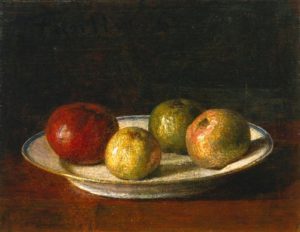
5. Give Us An Impression
Impressionism proved that fleeting glimpses of objects provide as big a punch as those objects fully rendered in lifelike fashion. There is the “real” Rouen Cathedral and then there are Monet’s impressions of it. Imagine rendering an apple in the style of “Rouen Cathedral, Façade (Morning Effect).” It would still be an apple — but might look more like an iced version of itself!
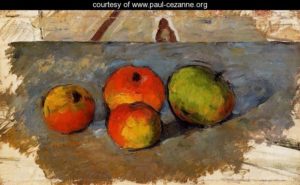
6. Use It In A Narrative

The apple may have its place, and get its look, as part of the narrative an artist is telling: as, for example, as part of a Garden of Eden or William Tell narrative painting. In the first painting it might need to look particularly delicious, in the second painting frightening by virtue of being hard to see (and hard to hit). Consider, as one example of the narrative use of an apple, Ford Madox Brown’s painting called “William Tell’s Son,” which shows a young boy holding an arrow-cleaved apple.
7. Use It Suggestively
What might an apple suggest? Rosiness? Health? Youth? Beauty? Might it suggest a simpler time, a quieter place, and a romantic idealization of America? Objects have cultural connections and artists can use them suggestively to put the viewer in mind of whatever it is the artist intends. To take one example, consider the following phrase: “He’s a bad apple.” In our culture, we understand what that phrase means—and how an artist might use an apple suggestively to portray evil.
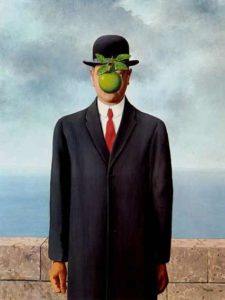
The professional artist doesn’t just “see an apple” and rush off to render it. He has intentions. The better you understand your intentions as an artist, the less trouble you will have knowing “what to do with” the objects of the world.
*****
If you have another method for choosing your subject matter, please share your tip with us in the comment section. Thanks, Lori 🙂
Here is a list of some other interesting articles:
How to Jump-Start Your Art Career
10 Ways to Overcome Mental Blocks & Boost Creativity
6 Tips for a Stress-Free Sketchbook
Charcoal Drawing Tips & Techniques
I hope to meet you all on Twitter & Facebook!








I like your suggestions Lori. Sometimes I just like to challenge myself and see how realistic I can be, or to do more of an impression of what is seen rather than being realistic at all.
Here is another suggestion: Try a new medium! If you work primarily in oil paint, how about giving watercolors a try? Or maybe pick up a ballpoint pen and see what you can do with it. I find altering the medium to be a great way of mixing it up and can often be fun to do.
Yes, I agree. Trying a new medium is a wonderful way to spark creativity. I also like how you challenge yourself with realistic and impressionistic styles. I need to try that myself.
Happy creating-
Lori
Excellent post Lori. I’ve been thinking about doing a very similar sort of post but have had other matters to attend to. Now I see I don’t need to bother – I shall just reference yours instead! 🙂
Haha, Katherine…I am sure you would come up with some great ideas yourself. If so, let me know about them. Thanks for the visit and comment.
Lori 🙂
I really enjoyed this post – a lot of effort and thought went into it – very inspiring.
How is this for an idea – page through and cut out images from old magazines then make collages with them, you could scan and resize images as required, then the pictures you come up with may speak to you and you can paint that. You could choose a theme – such as eating out, or rebirth , or what it means to be a mother – or whatever and choose images that relate to this.
In fact – I think I might just try it myself!
Hello Karen, and thanks for acknowledging the effort that goes into a post like this! Blogging is fun, but a lot of work. It makes it rewarding to hear back from friends like you – thanks.
I really like your additional tip. Thanks for sharing it. Let me know if you ever try it out, I’d love to see the process and the finished product.
Cheers-
Lori
Useful tips you have shared. i have had much trouble in coming up with topics to paint but this will help me out.thanks